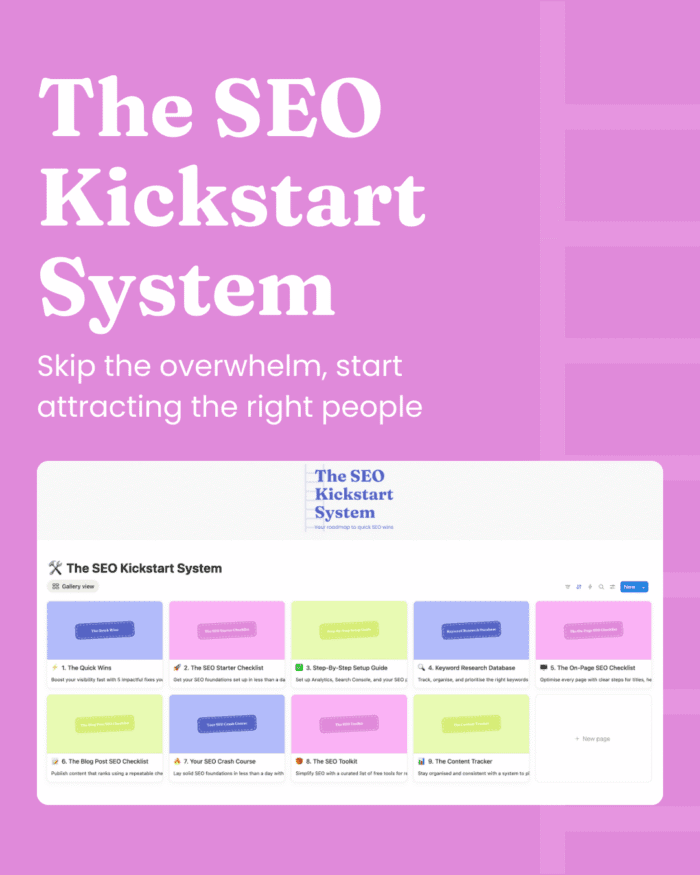You already know content matters. But between writing blog posts, posting on Instagram, sending emails and trying to keep up with the latest trends, it can feel impossible to manage.
Most small business owners end up creating content on the fly, posting when inspiration strikes or when they feel guilty for going quiet. The result? Stress, inconsistency and little to show for all the effort.
Here’s the truth: you don’t need to be everywhere, posting every day. What you need is a simple content strategy that runs almost on autopilot. One that helps you show up where your audience is, share valuable insights and build trust – without draining all your time or energy. This post will walk you through exactly how to do it.
1. Get clear on your audience and goals
Content only works when it’s directed at the right people. Before you open up a blank document or start drafting captions, ask yourself:
- Who am I trying to attract?
- What problem are they struggling with right now?
- What action do I want them to take next (book a call, join my list, buy a product)?
For example, a wedding photographer could create content on “How to plan an engagement shoot that feels natural” as it speaks directly to their dream client and showcases their expertise.
Getting clear on your audience keeps your content focused. It ensures you’re attracting potential clients, not just random likes and traffic.
2. Choose one core platform
Here’s where many small business owners burn out: trying to do all the platforms, all at once.
You don’t need to be everywhere. Start with one long-form platform that works well for search and longevity — like a blog, YouTube channel or podcast. This becomes your main content hub. The place where you publish valuable content that can be found months or even years later.
Blogging is especially powerful for small businesses because it can help you rank on Google and bring in consistent traffic without needing to constantly post.
Once you’ve chosen your hub, you can branch out and share snippets elsewhere.

Get Found Online Faster with SEO That Works
The SEO Kickstart System helps you optimise your website in just one weekend. With checklists, templates and guides, you’ll set up SEO the right way without the overwhelm.
Perfect for new business owners, creators and entrepreneurs who want to attract the right audience.
3. Repurpose into smaller pieces
Here’s the “autopilot” magic. Instead of creating something new every time you post, take one long-form piece and repurpose it into smaller content.
For example, from one blog post you could create:
- 3–5 bite-sized tips for Instagram
- A “mini story” or behind-the-scenes take on LinkedIn
- A short video answering a common client question
- A helpful newsletter expanding on one key point
This way, one piece of content works across multiple channels. You save time, your message stays consistent and your audience sees you show up regularly without you constantly starting from scratch.
Check out my guide on how to create a social media strategy.
4. Add client-focused calls to action
This is where so many small business owners go wrong: they share great content, but don’t tell their audience what to do next.
Every piece of content should guide your audience to take the next step:
- Blog → “Download my free checklist”
- Instagram post → “DM me if you’re struggling with this”
- Email → “Book a consultation today”
Without CTAs, content just educates. With CTAs, content converts.
Think of your content like a journey. Every post, video or email should naturally lead someone closer to becoming a client.
5. Create a simple system
The secret to consistency isn’t more motivation, it’s systems.
Here’s one simple workflow that works for many small business owners:
- Batch plan your content once a month around your business goals and client needs.
- Create one long-form piece of content as your hub.
- Repurpose that into smaller formats for social media, email or video.
- Schedule everything in advance using tools like Buffer, Later or even Notion.
- Track results: look at what’s bringing you traffic, leads or sales, then do more of that.
When you work in batches and follow a repeatable system, content creation becomes less overwhelming and more effective.
Final thoughts
Attracting clients with content doesn’t need to be complicated. Create a simple content strategy that runs almost on autopilot, by focusing on one main platform, repurposing strategically and including client-focused CTAs.
Start small. Stay consistent. Refine as you go.
Soon, you’ll have a streamlined system that brings in the right clients without the stress of trying to be everywhere, all the time.
